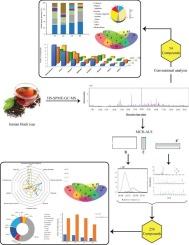利用 GC-MS 指纹的化学计量分析全面鉴定伊朗红茶中的挥发性化合物
IF 8.2
1区 农林科学
Q1 CHEMISTRY, APPLIED
引用次数: 0
摘要
红茶是一种广受欢迎的非酒精饮料,以其独特的香气而闻名,并因其复杂的成分而备受关注。然而,伊朗茶叶的化学成分在很大程度上仍未得到研究。在这项研究中,首先使用顶空固相微萃取-气相色谱-质谱法(HS-SPME-GC-MS)分析了伊朗北部四个主要茶叶种植区的红茶样品,以分离、鉴定和量化其挥发性有机化合物。随后,我们采用稳健的研究策略,首次利用著名的多元曲线解析-最小二乘法(MCR-ALS)作为解卷积技术,分析茶叶样品中复杂的气相色谱-质谱峰群。这种方法有效地解决了基线严重漂移、峰重叠和背景噪声等难题,从而确定了各种样品中造成独特风味和口感的次要成分。MCR-ALS 技术大大提高了光谱和洗脱曲线的分辨率,从而实现了对茶叶成分的定性和半定量分析。定性分析包括将分辨出的峰轮廓与理论光谱以及保留指数进行比较,而半定量分析则针对挥发性化合物采用总量积分(OVI)方法,在峰面积和浓度之间提供更准确的相关性。化学计量学工具在气相色谱-质谱分析中的应用增加了四种茶叶样品中可识别成分的数量,从 54 种增加到 256 种,浓度均超过 0.1%。其中,32 种挥发性化合物出现在每个茶叶样本中。烃类(包括烯烃、烷烃、环烷烃、单萜和倍半萜)、酯类和醇类是三大类化学物质,占挥发性化合物相对含量的 78%。对四个不同地区的红茶进行分析后发现,它们不仅在挥发性成分上存在差异,而且在相对比例上也存在差异。这种综合方法提供了对伊朗红茶挥发性化学成分的全面了解,增强了对不同产地红茶独特特征的认识,并为提高红茶质量奠定了基础。本文章由计算机程序翻译,如有差异,请以英文原文为准。

Comprehensive characterization of volatile compounds in Iranian black teas using chemometric analysis of GC-MS fingerprints
Black tea, a widely popular non-alcoholic beverage, is renowned for its unique aroma and has attracted significant attention due to its complex composition. However, the chemical profile of Iranian tea remains largely unexplored. In this research, black tea samples from key tea cultivation regions in four geographical areas in northern Iran were firstly analyzed using headspace solid-phase microextraction followed by gas chromatography–mass spectrometry (HS-SPME-GC–MS) to separate, identify, and quantify their volatile organic compounds. Subsequently, employing a robust investigative strategy, we utilized for the first time the well-known multivariate curve resolution-alternating least square (MCR-ALS) method as a deconvolution technique to analyze the complex GC–MS peak clusters of tea samples. This approach effectively addressed challenges such as severe baseline drifts, overlapping peaks, and background noise, enabling the identification of minor components responsible for the distinct flavors and tastes across various samples. The MCR-ALS technique significantly improved the resolution of spectral and elution profiles, enabling both qualitative and semi-quantitative analysis of tea constituents. Qualitative analysis involved comparing resolved peak profiles to theoretical spectra, along with retention indices, while semi-quantification was conducted using the overall volume integration (OVI) approach for volatile compounds, providing a more accurate correlation between peak areas and concentrations. The application of chemometric tools in GC–MS analysis increased the number of recognized components in four tea samples, expanding from 54 to 256 components, all with concentrations exceeding 0.1 %. Among them, 32 volatile compounds were present in every tea sample. Hydrocarbons (including alkenes, alkanes, cycloalkanes, monoterpenes and sesquiterpenes), esters and alcohols were the three major chemical classes, comprising 78 % of the total relative content of volatile compounds. Analyzing black teas from four distinct regions revealed variations not only in their volatile components but also in their relative proportions. This integrated approach provides a comprehensive understanding of the volatile chemical profiles in Iranian black teas, enhances knowledge about their unique characteristics across diverse geographical origin, and lays the groundwork for quality improvement.
求助全文
通过发布文献求助,成功后即可免费获取论文全文。
去求助
来源期刊

Food Chemistry: X
CHEMISTRY, APPLIED-
CiteScore
4.90
自引率
6.60%
发文量
315
审稿时长
55 days
期刊介绍:
Food Chemistry: X, one of three Open Access companion journals to Food Chemistry, follows the same aims, scope, and peer-review process. It focuses on papers advancing food and biochemistry or analytical methods, prioritizing research novelty. Manuscript evaluation considers novelty, scientific rigor, field advancement, and reader interest. Excluded are studies on food molecular sciences or disease cure/prevention. Topics include food component chemistry, bioactives, processing effects, additives, contaminants, and analytical methods. The journal welcome Analytical Papers addressing food microbiology, sensory aspects, and more, emphasizing new methods with robust validation and applicability to diverse foods or regions.
 求助内容:
求助内容: 应助结果提醒方式:
应助结果提醒方式:


